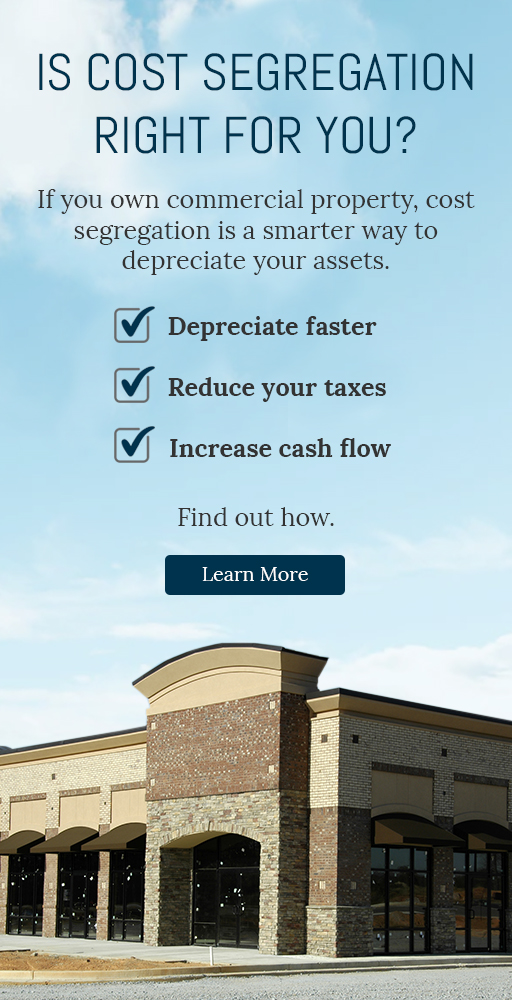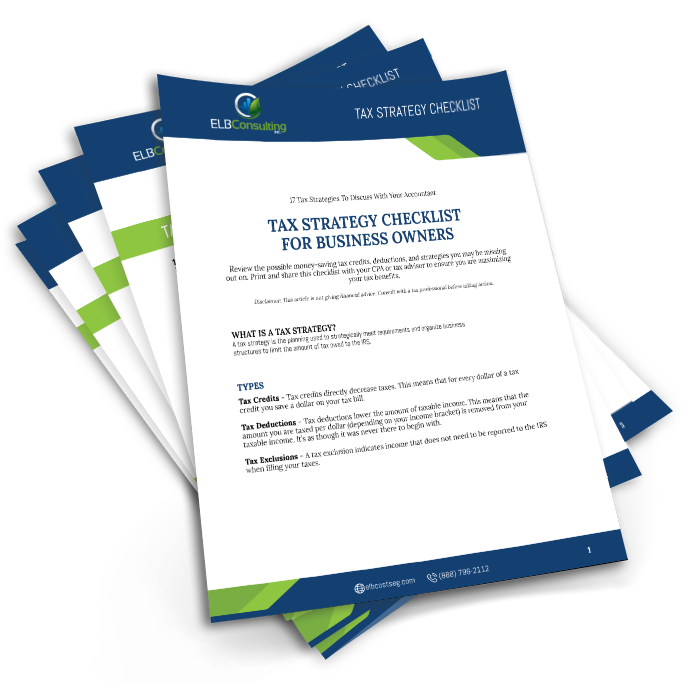How does a Cost Segregation Study provide tax benefits?
A cost segregation study is a strategic tax-planning tool that allows an owner to accelerate the depreciation of certain components of the building or land improvements over a shorter life. This is accomplished through a detailed analysis and component level breakdown of your commercial property, allowing the reclassification of specific real property assets into tangible personal property assets, which optimizes the depreciation schedule to leverage the ‘time value of money’.
The reclassification of tangible personal property from real property (giving it a shorter depreciable life) accelerates depreciation deductions that can allow for significant cash flow benefits through these increase tax deductions. The reduction of tax liability and the losses created from this are often classified by certain entities as ‘passive activity’.
Passive Activity (Income) LLC’s typically look to take full advantage of accelerated depreciation deductions through a cost segregation study to reduce tax liability and increase cash flow. It will offset any income created within a Limited Liability Corporation (LLC) for its real estate activity, reducing tax liability/generating losses and thus generating added cash flow.
How does passive activity really apply?
For real estate investors, a passive activity is one in which the owner of the real estate does not materially participate in the profession of real estate investments. It is important to know that any real estate rental activity is a passive activity, whether the taxpayer materially participates or not. Once the property is acquired or placed “in-service” as a real estate LLC, the taxpayer is either leasing the property to a third party or using the property as part of their own business operation. This typical arrangement will create a passive activity.
Many real estate owners who attempt to take advantage of these significant cash flow benefits do not realize that they are subject to passive activity losses, which can only be offset by passive income and potentially reduce the ability to take advantage of the tax benefits available through cost segregation. Therefore, proper tax planning and a clear understanding of cost segregation applications and guidelines are vital to obtaining maximum benefits from this tax strategy encouraged by the IRS.
“Cost Segregation is a lucrative Tax Strategy that should be used in almost every purchase of commercial real estate.”
The problem can arise when the investor creates excess depreciation, resulting in a passive activity loss beyond the passive income produced. The depreciation deductions are limited to the amount of rental income (passive income) and cannot be used to reduce ordinary income.
So, if enough passive income is not available as an offset, the passive loss will carry forward into the following tax year as a Net Operating Loss (NOL).
Currently, with the Tax Cuts Jobs Act (TCJA) and 100% Bonus Depreciation this will most likely occur, though the carry-forward means the LLC owner will not pay any taxes on this property for many years to come. Because of these passive loss/activity rules, it is critical that the taxpayer carefully plan their tax strategy to maximize this IRS tax strategy benefit. It is very important to work with a firm or CPA who clearly understands the nuances of cost segregation and how it will align with an overall tax strategy.

Most real estate investors and developers are engaged in the commercial real estate business because of the substantial tax benefits available through a coherent real estate tax strategy. Though the overall IRS tax code is so large and unwieldy, that sometimes great tax strategies within the code might be overlooked by the investor(s) or non-real estate focused CPAs.
Here are two tax strategies where cost segregation deductions can be used to offset ordinary income:
- Real Estate Professional or Active Participant
- Self-Rental Rules in a single “Economic Unit”
Real Estate Professional/Active Participant engaged in the material
participation
If you (or your spouse if filing jointly) qualify under the IRS definition of a Real Estate Professional or an Active Participant, then this passive activity or losses created can be used to offset ordinary income. This is a huge benefit as not only can the depreciation created losses be used to offset other ordinary income sources, it can also directly impact a spouse’s W-2 wages. So a $100,000 in depreciation deductions, can be used on the jointly filed tax return to offset any ordinary and passive income.
 As the qualifying Real Estate Professional or an Active Participant, you normally cannot be a traditional full-time W-2 wage earner. There can be exceptions to this rule, but you need to work closely with your CPA to ensure you are in complete compliance with IRS guidelines. This is the circumstance where the spouse often takes on this role as a real estate investing couple to offset the W-2 wages. Of course, as a commercial real estate professional it can also offset all your 1099 commission income.
As the qualifying Real Estate Professional or an Active Participant, you normally cannot be a traditional full-time W-2 wage earner. There can be exceptions to this rule, but you need to work closely with your CPA to ensure you are in complete compliance with IRS guidelines. This is the circumstance where the spouse often takes on this role as a real estate investing couple to offset the W-2 wages. Of course, as a commercial real estate professional it can also offset all your 1099 commission income.
To qualify for Real Estate Professional or an Active Participant status:
- a taxpayer must provide more than one-half of their (or the spouses) total personal services, in real property trades of businesses in which they materially participate, and
- perform more than 750 hours of services during the tax year in real property trades or businesses.
In short real property trade or business material participation will involve one or more of the following:
1) develop or redevelop, 2) construct or reconstruct, 3) acquire, 4) converts, 5) rent or leases, 6) operates and manages, and 7) brokers commercial real estate properties.
The IRS has more detailed definitions, and like any tax incentive provision ‘a test’ that involves a series of qualifying questions to be confirmed by your tax professional or CPA. Taxpayers should also prepare contemporaneous time logs that detail the services rendered to document and support their qualification in the event of an IRS audit.
Self-Rental Rule for owner-occupied buildings that are held in a separate LLC
A potential passive activity loss can be overcome by taxpayers who treat multiple entities as one “economic unit”, subject to a few stipulations. An owner-occupied property will qualify under the IRS testing criteria as a single economic unit.
 For example, if a dental practice is operating under an S-corporation and owns the building under a separate LLC, the typical strategy is to have the LLC break even each year by paying the necessary rent from the S-Corporation to the LLC to cover all expenses, which could reduce the need for the added deductions of cost segregation. However, by electing to treat the two (2) entities as one economic unit, all income or losses are considered active and become fully deductible in the year incurred. Using a Cost Segregation Study, the LLC would have large “pass through” losses relating to the accelerated depreciation that can offset the ordinary income of the business practice, operating as a single economic unit.
For example, if a dental practice is operating under an S-corporation and owns the building under a separate LLC, the typical strategy is to have the LLC break even each year by paying the necessary rent from the S-Corporation to the LLC to cover all expenses, which could reduce the need for the added deductions of cost segregation. However, by electing to treat the two (2) entities as one economic unit, all income or losses are considered active and become fully deductible in the year incurred. Using a Cost Segregation Study, the LLC would have large “pass through” losses relating to the accelerated depreciation that can offset the ordinary income of the business practice, operating as a single economic unit.
When grouping the building LLC with the operational business unit, this can eliminate the passive loss limitations to the building LLC and enable the dentist taxpayer, in this example, to take the depreciation deductions against their dental practice ordinary income to maximize the benefits from a cost segregation study.
There is a “facts and circumstance” test that should be performed to determine whether activities may be grouped together. The factors listed below, all do not need to be met to qualify, are given the greatest weight in determining whether activities constitute an appropriate “economic unit” for the measurement of gain or loss for purposes of IRS Treasury Reg §1.469-4:
1) Similarities and differences in types of trades or businesses; 2) The extent of common control; 3) The extent of common ownership; and 4) Geographical location; and Interdependencies between or among the activities.
This ‘self-rental’ or ‘economic unit’ rule is often overlooked to maximize passive activity deductions for owner-occupiers.
Cost segregation an effective tax strategy in more ways than one
Investing in commercial or income producing real estate is one of the world’s great wealth building strategies. Using cost segregation as a tool to optimize your depreciation schedule will result in significant cash flow and tax benefits in and of its own. The two strategies outlined in this article are just a couple added ways for you to leverage this passive activity against your ordinary income.
It is important to understand how to maximize a cost segregation study for your specific tax strategy on your income producing real estate investments. Speak with your CPA or Tax Professional to determine if you qualify to take advantage of these specific tax strategies.




